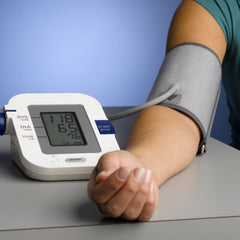Surprising Benefits of Regular Stretching! It's Even More Effective Than Brisk Walking in Lowering Blood Pressure
Table of Contents:
- When It Comes to Lowering Blood Pressure, Stretching Beats Brisk Walking
- What Other Benefits Does Stretching Offer?
- Five Key Tips for Safe and Effective Stretching
- Avoid Overstretching
- Consistency is key
- Avoid Holding Your Breath
- Stretch Within 15 Minutes After Exercise
- Avoid Bouncing Or Jerky Movements
- FAQs about Stretching Exercises
Stretching your arms, pulling your calves... Many people find stretching to be a relaxing activity, especially office workers who sit for long periods. Stretching not only relieves fatigue but also boosts overall health. A study has found that stretching can help improve blood pressure—and it’s even more effective than brisk walking.

When It Comes to Lowering Blood Pressure, Stretching Beats Brisk Walking
Research has shown that stretching is more effective than brisk walking in lowering blood pressure. The study recruited 40 men and women with an average age of 61, all of whom had either stage 1 hypertension or high-normal blood pressure. Participants were randomly assigned to two groups for an 8-week study. Both groups engaged in exercise five days a week for 30 minutes a day.
- Stretching group: This group performed 21 full-body stretching exercises. Each stretch was done twice, held for 30 seconds, with a 15-second rest between stretches.
- Brisk walking group: Participants walked briskly on outdoor paths, aiming to reach a certain heart rate; if the weather was poor, they walked on an indoor treadmill.
Both groups had similar diets and sodium intake. Blood pressure was monitored 24 hours a day using portable blood pressure monitors. Results showed that the stretching group experienced a significantly greater reduction in blood pressure compared to the brisk walking group. However, the walking group showed a greater reduction in waist circumference, although there was no significant difference in body weight between the two groups.
The analysis suggests that while aerobic exercise is generally recommended to lower blood pressure, previous studies have also found that stretching can reduce arterial stiffness, improve blood flow, and increase parasympathetic nervous system activity, thereby lowering blood pressure. When muscles are stretched, blood vessels are also stretched.
What Other Benefits Does Stretching Offer?
Helps Relieve Fatigue
Stretching is an excellent way to combat fatigue. Even a simple stretch can extend the muscles on both sides of the body and the back, promoting blood circulation and alleviating symptoms such as fatigue and muscle soreness.
Aids In Muscle Recovery After Exercise
Whether it’s aerobic exercise or strength training, muscles can become fatigued and tense afterward. Stretching at this time can effectively relieve muscle tension, promote recovery, prevent injuries, and enhance the effectiveness of your workout.
Improves Athletic Performance
Stretching helps improve athletic performance by enhancing flexibility and increasing or maintaining joint range of motion, allowing for better movements and reducing injury risk.
Five Key Tips for Safe and Effective Stretching
Avoid Overstretching
Stretching should stay within the joint’s normal physiological range of motion. Avoid excessive force to prevent muscle strains. Adjust the intensity based on your comfort, aiming for mild muscle tension without pain.
Consistency is key
Regular stretching over several weeks can significantly improve joint flexibility. Similarly, these health benefits require consistent practice to maintain.
Avoid Holding Your Breath
For older adults, safety during stretching is paramount. Avoid excessive force or breath-holding, and don’t tilt your head down too low or make sudden upward movements. Movements should be gentle and slow, with natural, smooth breathing.
Stretch Within 15 Minutes After Exercise
The best time to stretch is within 10–15 minutes after exercise, when the muscles are warm and more receptive, leading to better results.
Avoid Bouncing Or Jerky Movements
For flexibility training, avoid ballistic stretching, such as leg swings or shoulder bounces. Using momentum to push joints to their maximum range can trigger a protective rebound in the muscles, reducing the effectiveness of the stretch and increasing the risk of injury. Static stretching is a safer and more effective option in these cases.
FAQs about Stretching Exercises
Can Stretching Exercises Increase Height?
No, stretching exercises cannot actually increase your height. While stretching can improve your posture and make you appear taller by aligning your spine and reducing slouching, it does not lengthen your bones or promote actual growth. Once your growth plates close after puberty, your height is genetically fixed and cannot be increased through exercise.
Do You Stretch Before or After Exercise?
It is recommended to stretch both before and after exercise. Stretching before a workout helps prepare the muscles for activity and can reduce the risk of injury. After exercise, stretching aids in muscle recovery, improves flexibility, and may help reduce muscle soreness.
Do Stretches Count as Exercise?
Yes, stretches do count as exercise because they help maintain muscle flexibility, strength, and overall health. Regular stretching improves range of motion, reduces the risk of injury, and supports better posture and mobility.
Do Stretching Exercises Help Lose Weight?
While stretching exercises don't directly burn a significant number of calories, they can support weight loss indirectly by improving flexibility, enhancing performance in other workouts, and aiding recovery. Stretching also promotes better blood circulation and reduces stress, both of which can positively impact metabolism and overall health, making it a valuable part of a balanced fitness routine.





